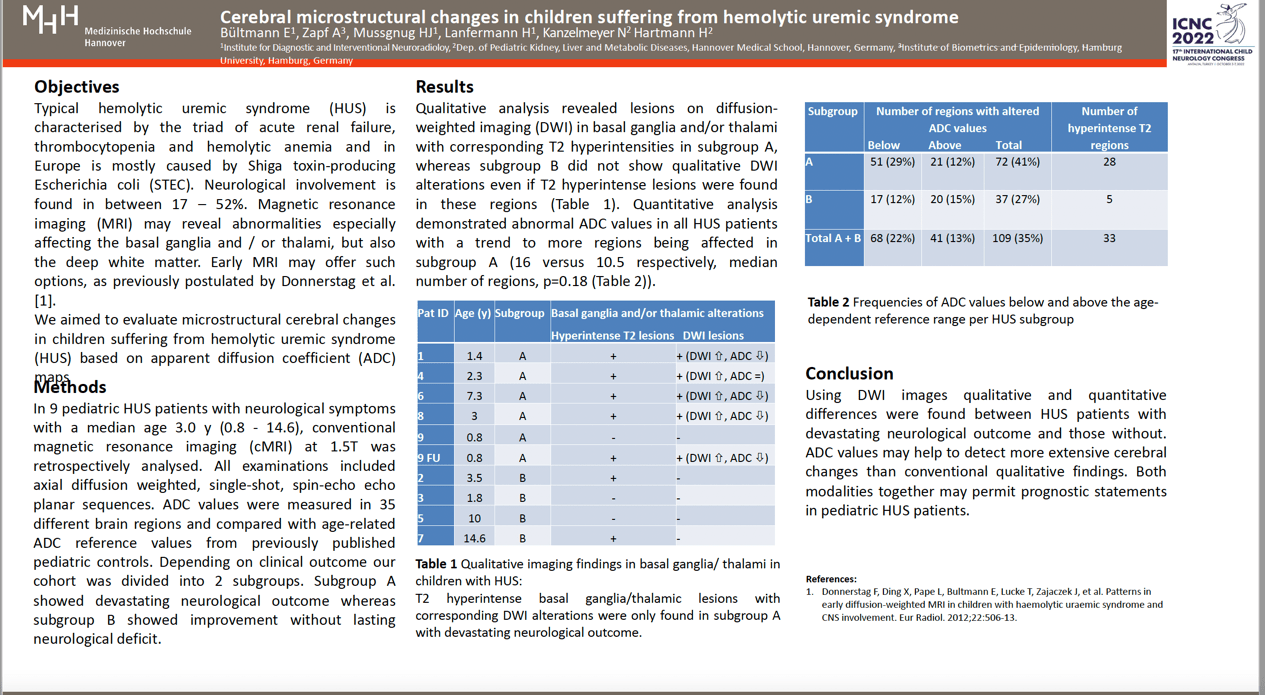Cerebral microstructural changes in children suffering from hemolytic uremic syndrome
Eva Bültmann, Antonia Zapf, Hans Joachim Mussgnug, Heinrich Lanfermann, Nele Kanzelmeyer, Hans Hartmann
Objectives: To evaluate microstructural cerebral changes in children suffering from hemolytic uremic syndrome (HUS) based on apparent diffusion coefficient (ADC) maps. Methods: In 9 pediatric HUS patients (0.8 - 14.6 years of age) conventional magnetic resonance imaging (cMRI) at 1.5T was retrospectively analysed. ADC values were measured in 35 different brain regions and compared with age-related ADC reference values from previously published pediatric controls. Depending on clinical outcome our cohort was divided into 2 subgroups. Subgroup A showed devastating neurological outcome whereas subgroup B showed improvement without lasting neurological deficit. Results: Qualitative analysis revealed lesions on diffusion-weighted imaging (DWI) in basal ganglia and/or thalami with corresponding T2 hyperintensities in subgroup A, whereas subgroup B did not show qualitative DWI alterations even if T2 hyperintense lesions were found in these regions. Quantitative analysis demonstrated abnormal ADC values in all HUS patients with a trend to more regions being affected in subgroup A (16 versus 10.5 respectively, median number of regions, p=0.18). Conclusion: Using DWI images qualitatively and quantitatively differences were found between HUS patients with devastating neurological outcome and those without. ADC values detect more extensive cerebral changes that go beyond the conventional qualitative findings. Both may permit prognostic statements in pediatric HUS patients.
Keywords: Hemolytic uremic syndrome; Magnetic Resonance Imaging; Quantitative Imaging; Diffusion-weighted Imaging
Eva Bültmann
Hannover Medical School
Germany
Antonia Zapf
Hamburg University
Germany
Hans Joachim Mussgnug
Hannover Medical School
Germany
Heinrich Lanfermann
Hannover Medical School
Germany
Nele Kanzelmeyer
Hannover Medical School
Germany
Hans Hartmann
Hannover Medical School
Germany
Objectives: To evaluate microstructural cerebral changes in children suffering from hemolytic uremic syndrome (HUS) based on apparent diffusion coefficient (ADC) maps. Methods: In 9 pediatric HUS patients (0.8 - 14.6 years of age) conventional magnetic resonance imaging (cMRI) at 1.5T was retrospectively analysed. ADC values were measured in 35 different brain regions and compared with age-related ADC reference values from previously published pediatric controls. Depending on clinical outcome our cohort was divided into 2 subgroups. Subgroup A showed devastating neurological outcome whereas subgroup B showed improvement without lasting neurological deficit. Results: Qualitative analysis revealed lesions on diffusion-weighted imaging (DWI) in basal ganglia and/or thalami with corresponding T2 hyperintensities in subgroup A, whereas subgroup B did not show qualitative DWI alterations even if T2 hyperintense lesions were found in these regions. Quantitative analysis demonstrated abnormal ADC values in all HUS patients with a trend to more regions being affected in subgroup A (16 versus 10.5 respectively, median number of regions, p=0.18). Conclusion: Using DWI images qualitatively and quantitatively differences were found between HUS patients with devastating neurological outcome and those without. ADC values detect more extensive cerebral changes that go beyond the conventional qualitative findings. Both may permit prognostic statements in pediatric HUS patients.
Keywords: Hemolytic uremic syndrome; Magnetic Resonance Imaging; Quantitative Imaging; Diffusion-weighted Imaging
Eva Bültmann
Hannover Medical School
Germany
Antonia Zapf
Hamburg University
Germany
Hans Joachim Mussgnug
Hannover Medical School
Germany
Heinrich Lanfermann
Hannover Medical School
Germany
Nele Kanzelmeyer
Hannover Medical School
Germany
Hans Hartmann
Hannover Medical School
Germany

Hans Hartmann
Hannover Medical School
Germany
Hannover Medical School
Germany